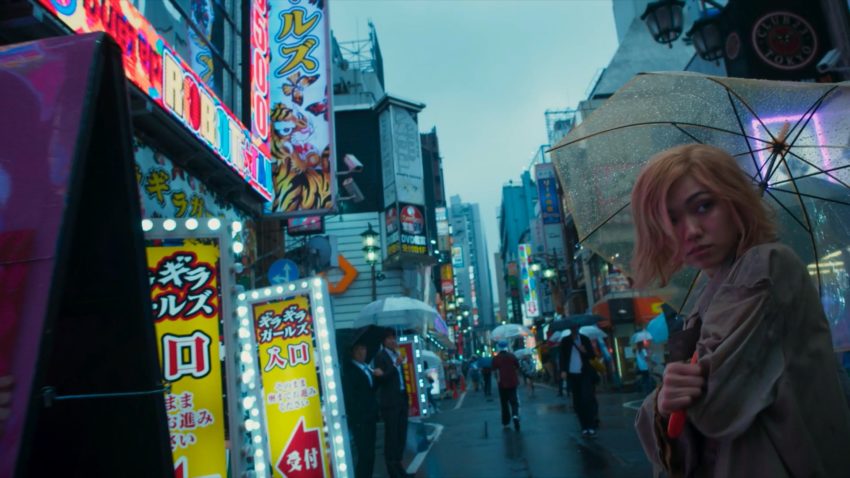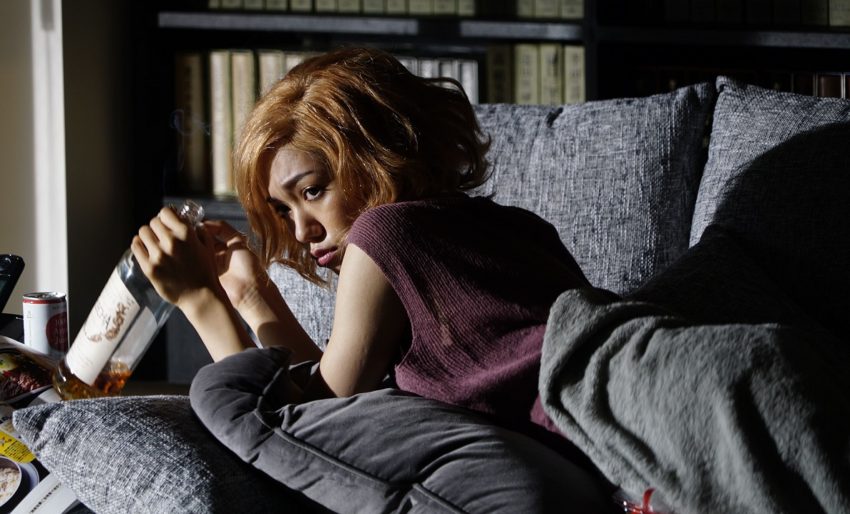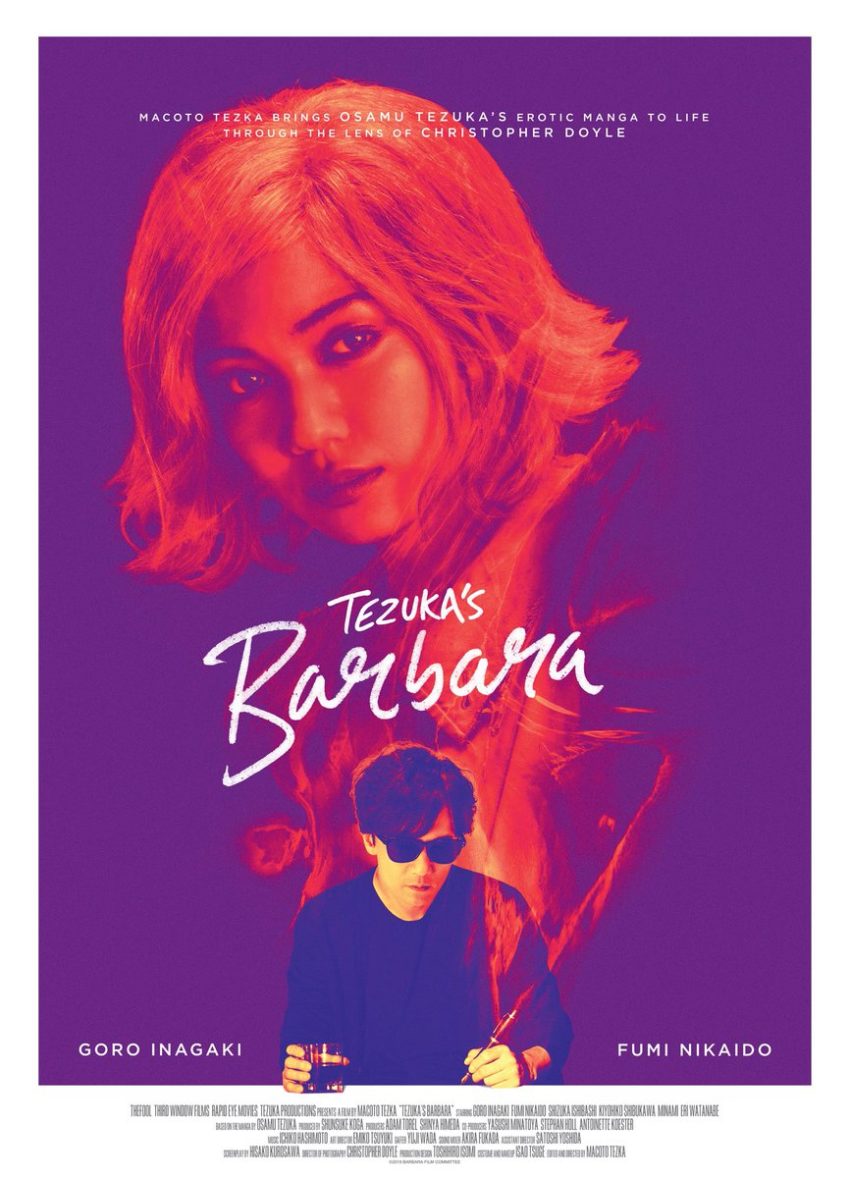Tezuka’s Barbara
August 22, 2021 · 0 comments
By Tom Wilmot.

An erotic and sexually charged story of introspection and insanity is unlikely to be the first thing one would associate with the “God of Manga” Osamu Tezuka. However, that’s precisely what you got with his 1973-74 manga series Barbara. The story is a dark and meditative journey into sexuality, perversion, and art, and is easily one of the legendary author’s most adult works. The complexity of the narrative and the fantastical way it’s told meant that, for many years, the story was deemed impossible to film; yet that is exactly what Tezuka’s son Macoto did in 2019. Now, almost two years on from its Japanese release, Tezuka’s Barbara makes its way to UK home media in all its demented glory, courtesy of Third Window Films.
Yosuke Mikura (Goro Inagaki) is an introverted and socially disconnected author who makes his living writing what he considers to be “rubbish” books. One day, he stumbles across an alcoholic young woman, Barbara (Fumi Nikaido), sleeping in a subway tunnel and decides to bring her home. A thorn in his side at first, Barbara proves to be a chaotically addictive force in Yosuke’s already troubled life as well as an inspiration for his writing. As the lines begin to blur between fantasy and reality, the writer is sent into a downward spiral of sexual obsession and delusion with Barbara at the centre.

Osamu Tezuka was not entirely unknown for his sexually charged works, what with his involvement in Mushi Pro’s notorious Animerama trilogy. Barbara is an exception, though, in the sense that the story explores the darker aspects of sexual obsession and perversion. Several of the more extreme events in the manga are realised in one form or another in the film, each of which is suitably jarring and disturbing. Not only do these sequences help to capture the dreamlike state of madness that Yosuke is tumbling into, but they’re also executed wonderfully given their fantastic nature. The director’s handling of these challenging scenes is excellent, particularly those that are more uncomfortable and explicit later in the film. Who would have thought such decadence could come from the same mind that brought us Kimba the White Lion?
One wonders what exactly Tezuka was trying to say with Barbara. Both the manga and film plots are disorienting and scattered, with everything from occult ceremonies to voodoo murders being thrown into the mix. Part of the reason for this odd concoction may be the fact that early chapters of the manga were criticised for being too subjective, which potentially led to Tezuka incorporating elements, such as the occult, that would pander to contemporary public interest. Every plot element is supplemental to the conflict at the heart of the film, that being Yosuke’s creative struggles and his general disdain for life. The arrival of Barbara seems to awaken something within the writer, a lost passion, the stirring of which leads to his turbulent downfall. Tezuka’s original work could be interpreted as a commentary of the hardships of being an artist, although it would be foolish to try and narrow either the manga or film down to one particular meaning. Barbara in both formats is very much a case of “you’ll get out what you put in,” so it’s sure to be a personal experience for most audiences.
While the ambiguity of the narrative is welcome, unfortunately, the muddled nature of the plot is where the film struggles most as an adaptation. The early adventures of Yosuke and Barbara in the manga are more episodic, and while this is realised in the first chunk of the film, it does leave a feeling of aimlessness. Up until the final third, it’s unclear where the plot is headed, so it’s a challenge to remain engaged in the journey. Such a directionless narrative might not be an issue were it not for the severely staggered pacing, which sees several sequences toward the back end of the running time drag considerably. Another somewhat damning factor in terms of emotional investment in the story is that the eventual romance between Yosuke and Barbara feels a little cold, despite the intimacy with which it’s portrayed. While this distant and unfulfilling tale of love works thematically, it’s difficult to really care about the couple and their plight.

Any emotional attachment that is to be garnered from the movie comes from the performances, notably that of Inagaki, who carries the film with his moody portrayal of Yosuke. He’s accompanied by the playful Nikaido, whose Barbara is a mysterious, sensual, and often grating presence ripped straight from the pages of the manga. Another notably alluring figure is that of the surname-less Minami, who, as Yosuke’s would-be lover Shigako Satomi, shines in one of the film’s more bizarre sexual fantasies. Japanese film lovers may also recognise the actress from her cameo role of Keiko in Kinji Fukasaku’s Battle Royale.
One element of Tezuka’s Barbara that’s undeniably masterful is the cinematography from seasoned cameraman Christopher Doyle. Having lensed films for the likes of Wong Kar Wai and Fruit Chan, the industry veteran utilises all of his talents to compose a series of moody and occasionally surreal visuals that perfectly set the movie’s tone. From the cold and imposing shots of the city-scape to a tantalisingly dreamy nightclub sequence, the film is a consistent feast for the eyes. Complementing the production also is a chaotic jazz score from composer Ichiko Hashimoto, who anime fans may be interested to know lent her voice acting talents to the role of Aisha’s mother in Lupin III: The Woman Called Fujiko Mine. Everything about the production, from the wonderful performances to the gorgeous visuals, help bring the world of Osamu Tezuka’s manga to life, yet the distant narrative does mean that real emotional investment goes begging.
Accompanying Third Window’s release is a half an hour behind-the-scenes featurette. The footage covers the production from start to finish and touches on everything from rough beginnings to emotional goodbyes. One particularly interesting segment reveals how a deceptively simple-looking stunt was pulled off, while other moments offer insight into how Tezuka junior operates as a director.

The release also includes a handful of deleted scenes that, in truth, were understandably cut from the film but are a welcome addition to the set nonetheless. The most notable of these omitted scenes is an alternate ending that strips away much of the ambiguity from the final cut. While this more definitive conclusion might have proven to be more satisfying in some regard, the open-endedness of the existing finale fits more with the film’s subjective viewing experience.
Rounding out the set is a series of interviews with the cast and crew in which Tezuka’s original manga, the importance of collaboration, and thoughts on the film as an international co-production are all discussed. The longest of these interviews is with the director himself (he insists on the non-standard romanisation Macoto Tezka), who goes into detail as to how the stars aligned for the project to come to life after he’d been toying with the idea of adapting his father’s manga for many years. The way that the director talks about the complexities of the characters and the world of Barbara speaks volumes as to how much care has gone into this personal project. By far, the most interesting interview on the disc is with Christopher Doyle, who speaks passionately about his wider goals as a cinematographer. Doyle has a way of describing cinematography and the beauty of capturing an image on film that is quite extraordinary. If anything, this interview will have you seeking out more of his thoughts on the craft that he clearly loves.
For both better and worse, there’s no denying that Tezuka’s Barbara is a film that truly stands alone. The fact that Macoto Tezka has succeeded in putting his father’s manga to screen in such a cohesive manner is an achievement in and of itself. That the film also stands as an enticing piece of art cinema in its own right is further testament to Tezka’s prowess as a director. The ambiguous nature of the film, along with its narrative shortcomings, are sure to be off-putting to some, though as an adaptation of one of Osamu Tezuka’s most adult works, it’s certainly worth the watch. A string of revealing interviews and a comprehensive behind-the-scenes featurette means that Third Window Film’s release is the best way to experience this sensual feature. All that’s missing is an audio commentary to give us some idea of what the hell’s going on at certain points! That being said, there’s intrigue in the ambiguity, and it’s this element above all else that is sure to keep Tezuka’s Barbara lingering in people’s minds long after the credits roll.
Tezuka’s Barbara is released in the UK by Third Window Films.
Leave a Reply